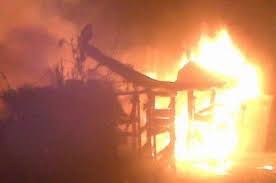Peat Wildfires occur in well-dried areas with peat soils or with a thick layer of forest litter (up to 20 cm or more) and represent a further stage in the development of low-level fires. The fire spreads over the peat layer slowly – up to several meters per day, but the combustion takes place to the entire depth of the layer or to the mineral (earth) soil.
In the first stage of the fire, the drier peaty layer burns out only under the trees, then the burning continues deep into the peaty layer. The burning rate of peat in windless weather or in light wind is 0.18 kg / (m2 • s). With a wind speed of 3 m / s and more often, scattering of burning peat particles in the wind over considerable distances occurs, which, falling on a layer of dried peat on the surface, ignite it, forming new foci of combustion.
There are three fronts of Peat Wildfires, depending on the speed of advancement of fire:
- 1) main (moving in the direction of the wind with the highest speed);
- 2) flank (move to the side of the leading front with a lower speed);
- 3) rear (moves towards the wind with the lowest speed) [6].
The development of peat fires is influenced by various meteorological factors. At night, due to the fact that the temperature of the peat surface is below the temperature of the deposit and as a result, moisture rises to its upper layers, the fire develops more slowly.Underground peat fires usually arise from grassroots and themselves spread very slowly, so the primary task is to extinguish a bottom fire, then proceed to the elimination of the centers of underground fire.
Direct consequences all fires:
- Vegetation: As a consequence of the destruction of the vegetation, opportunistic species such as herbaceous and pyrophyte plants, fast growing, occupy the space, and when fires are repetitive they can displace other affected species.
 Fauna: Heat and suffocation cause the emigration of birds and vertebrates, the invertebrates that inhabit the mulch disappear drastically. The destruction of the ecosystem and the food chain makes it difficult for wildlife to recover.
Fauna: Heat and suffocation cause the emigration of birds and vertebrates, the invertebrates that inhabit the mulch disappear drastically. The destruction of the ecosystem and the food chain makes it difficult for wildlife to recover.- Water wealth: The loss of vegetation increases the waterproofing of the soil and prevents the infiltration of rainwater, resulting in a considerable increase in runoff that takes the fertile layer. There is the fact that water quality deteriorates considerably due to contamination in suspension.
- The atmosphere: Liberan C02 fires and other gases , such as nitrogenous compounds and various hydrocarbons, ash particles and coal.
- Soil: Erosion caused by fires causes a loss of soil that is difficult to repair Physical erosion consists in the disappearance of the different layers of soil due to loss of vegetation and water runoff. Chemical erosion is the loss of nutrients and therefore the decrease in fertility.
- Soil microorganisms: Bacteria and fungi responsible for important biological processes, (as an example we will say that they live in symbiosis with large trees and growth and health depends on this process). Fire is the cause of irreparable damage to these microorganisms. .
- Landscape: Fire destroys ecosystems and prevents the use of mountains and forests, deteriorates the landscape, prevents productive use, the development of living beings and our need to enjoy leisure in nature.
